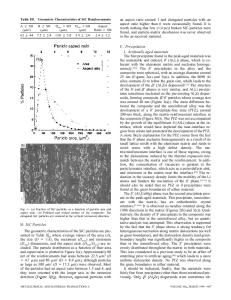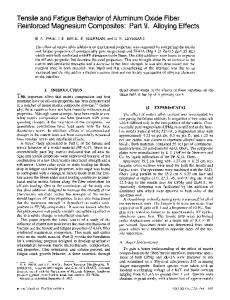Tensile properties of short fiber-reinforced SiC/Ai composites: Part I. effects of matrix precipitates
- PDF / 1,574,548 Bytes
- 10 Pages / 594 x 774 pts Page_size
- 46 Downloads / 353 Views
I.
INTRODUCTION
A L U M I N U M alloys reinforced with SiC particles or whiskers are currently being used in small production applications and may soon be used as major structural components of aircraft. The incorporation of SiC dispersoids in the aluminum matrix increases stiffness and strength while conserving the isotropic nature and some of the traditional fabricability and formability of aluminum alloys. The powder metallurgy (PM) technique for producing these composites was first introduced in 1967, m and cast versions became available in the mid1980's. Because these composites are discontinuously reinforced and generally much weaker than continuous filament composites, the mechanical properties of the matrix alloy play a significant role in the overall properties. Various age-hardening aluminum alloy matrices have been used, and it has been found that the increment in strength obtainable by age hardening is usually equal to or greater than that due to the SiC additions. Despite this, the role of matrix precipitation has not been emphasized in much of the work on the strength of these materials. Thus, this work is part of an attempt to perform a systematic examination of the effects of whiskers, particles, and precipitates on the deformation of aluminum matrix composites. In this first part, we present results obtained from tensile experiments on a series of composites made with solution-hardened and precipitation-hardened matrices. In Part 11,]341 we will present the results of finite-element modeling performed to help understand these experimental results. The strength of aluminum alloys reinforced with particles or whiskers of SiC has been the subject of several investigations and some controversy. Initially, the strength was accounted for as a superposition of precipitation hardening and Orowan strengthening, t2] This was fol-
J.M. PAPAZIAN, Principal Staff Scientist, and P.N. ADLER, Director, Materials and Structures, are with the Corporate Research Center, Grumman Corporation, Bethpage, NY 11714-3580. Manuscript submitted June 22, 1989. METALLURGICAL TRANSACTIONS A
lowed by the observation of high dislocation densities near SiC whiskers ( ~ 2 x 1014 m -e) and the suggestion that the observed strengthening was mainly due to these dislocations and a fme distribution of Guinier-Preston (G-P) zones.[3] Further work in support of this hypothesis led Arsenault i41 to describe the ultimate tensile strength of SIC/6061 in terms of a high (1015 m -2) dislocation density, a fine subgrain size, precipitation hardening, and approximately one-fourth of the strengthening predicted by shear lag theory. Nieh and Chellman tS] pointed out the low proportional limit of a variety of composites. In an early review, Nair et al. ,[6] however, thought that analytical treatments based on the Tsai-Halpin equation satisfactorily accounted for existing results. McDanels tT] did experiments on the tensile behavior of SiC particulate-, whisker-, and nodule-reinforced composites using 2024, 6061, and 7075 matrices and concluded t
Data Loading...










